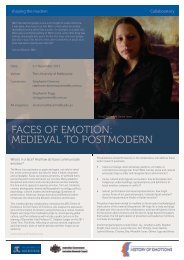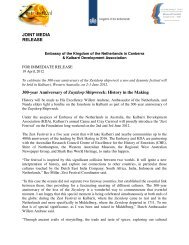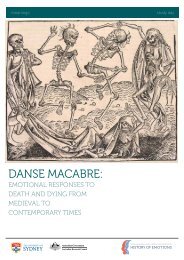Download our K-12 education pack - ARC Centre of Excellence for ...
Download our K-12 education pack - ARC Centre of Excellence for ...
Download our K-12 education pack - ARC Centre of Excellence for ...
You also want an ePaper? Increase the reach of your titles
YUMPU automatically turns print PDFs into web optimized ePapers that Google loves.
stories <strong>for</strong> teachers & students 2013<br />
Supporting Res<strong>our</strong>ces<br />
Dutch Lives in the World<br />
stories by winthrop pr<strong>of</strong>essor susan broomhall<br />
Shipwrecked on the Great Southland<br />
The Dutch knew with certainty about a southern land from the<br />
time <strong>of</strong> the Duyfken’s landing in 1606. After Dirk Hartog’s 1616<br />
investigations in the Eendracht, the west coast was commonly<br />
referred to as Eendrachtsland by fellow Dutch seafarers within<br />
the VOC. Trialling the new Brouwer’s route, a quicker, southerly<br />
route to Batavia which could return pr<strong>of</strong>its even faster <strong>for</strong> the<br />
company, placed many ships on a direct path to the west coast <strong>of</strong><br />
Australia, but knowing when to turn to the north was difficult.<br />
This led to a series <strong>of</strong> near-misses which were duly reported<br />
back to the VOC directors with pleas that instructions should be<br />
altered to turn earlier than the <strong>of</strong>ficial recommendations. These<br />
included the Batavian Governor-General Coen himself, who had<br />
been travelling with the Galias, Utrecht and Texel in 1627 when<br />
they perceived breakers <strong>of</strong>fshore the continent. Coen urged the<br />
Directors to amend instructions as ‘a matter <strong>of</strong> the highest<br />
importance, which if not properly attended to involves grievous<br />
peril to ships and crews (which God in his mercy avert).’<br />
The Batavia which struck Morning Reef near Beacon Island<br />
(1629), the Vergulde Draeck wrecked <strong>of</strong>f Ledge Point, just over<br />
100 kilometres north <strong>of</strong> Perth (1656), the Zuytdorp destroyed in<br />
the remote coast between Kalbarri and Shark Bay (17<strong>12</strong>) and the<br />
Zeewijk which hit Half Moon Reef in the Houtman Abrolhos<br />
islands (1727) were less <strong>for</strong>tunate. Some 40 drowned on the<br />
Batavia, 118 on the Vergulde Draeck, 106 on the Zeewijk, while the<br />
number on the Zuytdorp is unknown. Not all those who<br />
experienced shipwrecks lived to tell the tale, but those who did<br />
recorded their fear and despair. François Pelsaert, on the<br />
Batavia, recorded how people were transferred from the vessel to<br />
the land amid ‘the loud lamentations raised on board by women,<br />
children, sick people, and faint-hearted men’. Once on land, he<br />
left the greater part <strong>of</strong> the crew to search <strong>for</strong> water be<strong>for</strong>e<br />
deciding to sail directly <strong>for</strong> the colony in search <strong>of</strong> help.<br />
dual interests, although the Governor General and Councillors<br />
confessed in their instructions, ‘there remains <strong>for</strong> us, in view <strong>of</strong><br />
the long lapse <strong>of</strong> time, very little hope that these people will still<br />
be found alive’. They revealed their darkest fears ‘that they have<br />
perished through hunger and misery or have been beaten to<br />
death by savage inhabitants and murdered’ but also their own<br />
feelings <strong>of</strong> responsibility to send yet more searches ‘so as not to<br />
fail in any duty that could be demanded <strong>of</strong> us in searching <strong>for</strong><br />
these poor souls in case they should be alive, or any <strong>of</strong> them.’<br />
They made clear to the captains <strong>of</strong> the Waekende Boei and<br />
Emeloordt in December 1657 that although they should salvage<br />
what they could from the wreck, ‘<strong>our</strong> opinion however is that in<br />
view <strong>of</strong> the great peril and danger this will not happen, since we<br />
deem human life more precious than goods.’<br />
Hopes were high <strong>for</strong> both captains. When Samuel Volkersen,<br />
Waekende Boei’s captain, saw a large fire on the coast, he ‘hoped<br />
it was lit by Christian people’. Aucke Pieterszoon Jonck likewise<br />
spotted fires ashore and, ‘rejoicing in <strong>our</strong> hearts’, sent a boat<br />
to the spot, sailing <strong>of</strong>f ‘in God’s name’. Although many shipboard<br />
items and timbers were recovered, neither ship located<br />
survivors. Yet the VOC had still not given up. Ships from the Cape<br />
were advised to keep a look out <strong>for</strong> Draeck survivors <strong>for</strong> many<br />
years as they passed by the west coast, as was Vlamingh some<br />
<strong>for</strong>ty years later in 1696-7.<br />
Emotions ran high at the news <strong>of</strong> Batavia’s loss. Coen sent<br />
Pelsaert back immediately in the Sardam to recover the<br />
‘250 souls altogether, men, women, as well as children, left on<br />
certain islands or rocks … in the uttermost misery to perish <strong>of</strong><br />
thirst and hunger’. Coen’s disbelief at Pelsaert’s abandonment<br />
<strong>of</strong> his crew was palpable: he was ordered to proceed ‘most<br />
hastily at the place where you have lost the ship and left the<br />
people’. Pelsaert had dishon<strong>our</strong>ed the reputation <strong>of</strong> the VOC<br />
by his actions, with senior councillor Antonie van Diemen<br />
describing the ship and its people as ‘shamefully left’ by<br />
Pelsaert’s group who had taken more provisions with them<br />
than they had left <strong>for</strong> the remaining passengers.<br />
When the Vergulde Draeck was likewise wrecked in 1656, a group<br />
<strong>of</strong> its crew sailed north to Batavia in search <strong>of</strong> assistance, having<br />
watched others attempting to refloat the boat on the shore, from a<br />
distance at which they could not be themselves boarded. Selfpreservation<br />
was high on the agenda, but this was mixed with guilt<br />
at survival and duty to those 68 who had been left behind. Certainly<br />
the VOC councillors perceived their responsibilities to these<br />
passengers, upon hearing the ‘sorrowful news,’ it sent three<br />
further ships over the next year to seek out survivors ‘in their<br />
sorrowful state … anxiously awaiting all needed com<strong>for</strong>t and help<br />
from here’, at a futher loss <strong>of</strong> 11 men.<br />
Instructions <strong>for</strong> these vessels were ‘to save the unhappy persons<br />
and the Company’s cash and goods’. The Vergulde Draeck had<br />
held an estimated 185 00 guilders’ worth <strong>of</strong> cargo including 8<br />
chests <strong>of</strong> silver coins. Further attempts at recovery served these<br />
FAR FROM HOME: ADVENTURES, TREKS, EXILES & MIGRATION<br />
59












